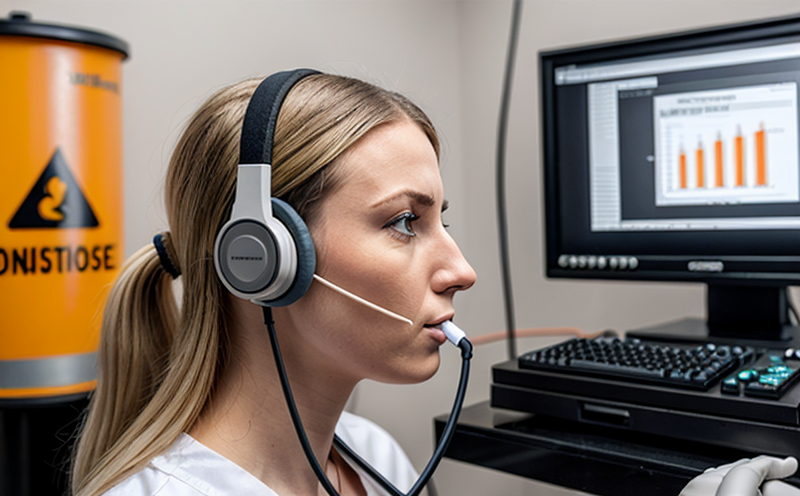ISO 11200 Determination of Noise Emission in Occupational Settings
The ISO 11200 standard provides a method for determining noise emissions in occupational settings. This is critical for ensuring that workers are not exposed to excessive levels of noise, which can lead to hearing damage and other health issues. Compliance with this standard ensures that employers meet their legal obligations under various national regulations such as OSHA (Occupational Safety and Health Administration) in the United States.
The test involves measuring sound pressure levels at specific points around a source, typically machinery or equipment, using sound level meters calibrated according to ISO 61672. The measurements are taken over a representative working day and averaged over time to ensure an accurate representation of the noise environment. The results are compared against established exposure limits defined by the standard.
The methodology is designed to account for variations in work practices, equipment design, and environmental factors that can influence sound levels. This ensures that the measurements obtained accurately reflect real-world conditions and provide a reliable basis for assessing compliance with national and international noise regulations.
Understanding the specific requirements of ISO 11200 involves recognizing its focus on providing a standardized approach to measuring noise emissions in occupational environments. The standard is intended to be used by manufacturers, designers, and engineers who need to ensure their products meet safety standards before being brought to market or introduced into workplaces.
For those responsible for managing health and safety within organizations, adherence to ISO 11200 helps demonstrate commitment to worker well-being. It also aids in identifying potential areas where improvements can be made regarding noise reduction measures. By implementing this standard, companies not only comply with legal requirements but also enhance their reputation as responsible employers.
The application of ISO 11200 extends beyond mere compliance; it plays a crucial role in preventing occupational hearing loss by providing accurate data on noise levels encountered during work activities. This information can then be used to implement effective control strategies aimed at reducing harmful exposures while maintaining productivity levels.
| Equipment | Description |
|---|---|
| Sound Level Meter | An instrument designed for measuring sound pressure levels; calibrated according to ISO 61672. |
| Anechoic Chamber | A room lined with absorbing materials to prevent sound reflections, used for precise measurements in controlled conditions. |
| Sound Source | The equipment generating noise whose emissions are being measured; could be anything from industrial machinery to office equipment. |
| Worker Models | Representative models that simulate human behavior during typical work tasks, used for assessing realistic exposure scenarios. |
In conclusion, ISO 11200 offers a robust framework for determining noise emissions in occupational settings. By following its guidelines, organizations can ensure they are meeting both legal and ethical obligations towards their employees' health and safety.
Industry Applications
- Manufacturing plants where continuous machinery operation produces high levels of sound.
- Construction sites with heavy equipment such as bulldozers, jackhammers, etc.
- Hospitals and healthcare facilities dealing with diagnostic imaging machines.
- Transportation industries including aircraft manufacturing and rail operations.
- Office environments where background noise from air conditioning units or ventilation systems is significant.
The versatility of ISO 11200 allows it to be applied across various sectors, making it an essential tool for maintaining a safe working environment. Each industry has unique challenges when it comes to managing noise pollution; therefore, understanding how these standards apply specifically within those contexts helps tailor solutions more effectively.
Why Choose This Test
Selecting the ISO 11200 standard for determining noise emissions is advantageous due to several key factors:
- Legal Compliance: Ensures adherence to national and international safety regulations.
- Risk Management: Identifies potential hazards early, allowing for proactive mitigation measures.
- Health Protection: Minimizes risk of occupational hearing loss through precise measurement.
- Economic Benefits: Can lead to cost savings by preventing costly litigation and worker compensation claims.
- Reputation Enhancement: Demonstrates commitment to employee well-being, improving public image.
By choosing this test, organizations invest in their workforce's safety while also safeguarding themselves against unnecessary risks. This proactive approach not only fosters a healthier workplace culture but also contributes positively towards overall business operations and performance.
Environmental and Sustainability Contributions
The determination of noise emissions through ISO 11200 aligns closely with broader sustainability goals by promoting quieter, more efficient workplaces. Quieter environments contribute to reduced stress among workers, which in turn promotes healthier lifestyles both inside and outside the workplace.
- Reduced Stress Levels: Lower noise levels can significantly decrease stress associated with loud working conditions.
- Energy Efficiency: Quieter equipment tends to be more energy-efficient because it doesn't need as much power to operate effectively.
- Better Air Quality: By reducing the use of air conditioning units, for instance, less electricity is consumed leading to cleaner air indoors.
In addition, by ensuring that all noise-emitting equipment complies with ISO 11200, organizations contribute positively towards creating sustainable practices within their industries. This aligns closely with global initiatives aimed at reducing environmental impact and promoting responsible corporate citizenship.





